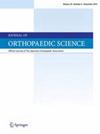脊柱骨盆矫正手术前后成年脊柱畸形患者背部和下肢肌肉活动、全身矢状排列、身体摇摆以及与健康相关的生活质量的定量评估:从 "经济锥 "的角度。
IF 1.5
4区 医学
Q3 ORTHOPEDICS
引用次数: 0
摘要
背景和目的:与成人脊柱畸形(ASD)相关的腰部和下肢疼痛和肌肉疲劳明显限制了日常活动并影响生活质量。本研究旨在明确脊柱矫正手术是否会降低肌肉活动要求,这与排列和平衡参数有关:方法:对 16 名 ASD 患者手术前后的腰部和下肢综合肌电图(I-EMG)研究以及全身对齐、身体摇摆和健康相关生活质量(HRQOL)进行了评估。16 名健康志愿者作为对照组。在静息和工作站姿时,使用表面肌电图测量双侧腰椎旁、股二头肌、股直肌、腓肠肌和胫骨前肌的肌肉活动。手术效果是根据肌肉疲劳的改善情况(使用整块肌肉 I-EMG 和身体摇摆的总和)得出的。HRQOL 采用 SRS-22r(测量 4 个领域(功能、疼痛、自我形象、心理健康)和小总分)进行评估:在对照组中,静息站立姿势下 10 个整体 I-EMG 的总和(mVms;平均值 ± SD)为 3316 ± 1247,工作站立姿势下为 5625 ± 2065。ASD患者的I-EMG值高于健康受试者;在静息站立位时,10个I-EMG的总和从基线(9125±3529)显著下降到术后3个月(6088±1793)和6个月(6381±1776)(P 结论:ASD患者的I-EMG值高于健康受试者:脊柱骨盆矫正手术后,全身矢状排列得到改善,基于 I-EMG 的肌肉活动和身体摇摆明显减少。术后的 SRS-22r 评分也有明显改善,表明站立姿势下的肌肉疲劳得到改善,即 "经济锥体 "恢复正常。本文章由计算机程序翻译,如有差异,请以英文原文为准。
Quantitative assessment of muscle activity of back and lower extremities, whole body sagittal alignment, body sway, and health-related quality of life in adult spinal deformity patients before and after spinopelvic correction surgery: From the standpoint of the “cone of economy”
Background and aims
Pain and muscle fatigue in the low back and lower extremity associated with adult spinal deformity (ASD) markedly limit daily activities and affect quality of life. This study aimed to clarify if spinal correction surgery decreases the muscle activity requirements in relation to alignment and balance parameters.
Methods
Integrated electromyogram (I-EMG) studies of the low back and lower extremity in addition to whole body alignment, body sway, and health-related quality of life (HRQOL) were evaluated in 16 patients with ASD before and after surgery. Sixteen healthy volunteers were included as control subjects. Muscle activities of the bilateral lumbar paravertebral, biceps femoris, rectus femoris, gastrocnemius, and tibialis anterior were measured using surface electromyogram in both resting and working standing positions. Surgical outcomes were based on improvements in muscle fatigue using the sum of the whole muscle I-EMGs and body sway. HRQOL was evaluated by SRS-22r, which measures 4 domains (function, pain, self-image, mental health) and subtotal scores.
Results
In controls, the sum of the 10 whole I-EMGs (mVms; mean ± SD) was 3316 ± 1247 in the resting standing position and 5625 ± 2065 in the working standing position. The I-EMG values were higher in ASD patients than in healthy subjects; in the resting standing position, the sum of the whole 10 I-EMGs significantly decreased from baseline (9125 ± 3529) to 3 (6088 ± 1793) and 6 (6381 ± 1776) months postoperatively (p < 0.01). In the working standing position, the sum in ASD patients also significantly decreased from baseline (14,160 ± 5474) to 3 (8085 ± 2540) and 6 (8557 ± 3025) months postoperatively (p < 0.01). I-EMG values did not differ significantly between the 3- and 6-month time points in either condition. Body sway was also improved postoperatively at 3 months and maintained at 6 months along with the amelioration of whole-body sagittal alignment, and 4 domains and subtotal SRS-22r scores significantly increased postoperatively.
Conclusion
Following spinopelvic correction surgery, whole body sagittal alignment was improved, and muscle activity based on I-EMG and body sway were significantly decreased. The SRS-22r scores after surgery also indicated significant improvement, suggesting that muscle fatigue in the standing position was ameliorated, i.e., the “cone of economy” was normalized.
求助全文
通过发布文献求助,成功后即可免费获取论文全文。
去求助
来源期刊

Journal of Orthopaedic Science
医学-整形外科
CiteScore
3.00
自引率
0.00%
发文量
290
审稿时长
90 days
期刊介绍:
The Journal of Orthopaedic Science is the official peer-reviewed journal of the Japanese Orthopaedic Association. The journal publishes the latest researches and topical debates in all fields of clinical and experimental orthopaedics, including musculoskeletal medicine, sports medicine, locomotive syndrome, trauma, paediatrics, oncology and biomaterials, as well as basic researches.
 求助内容:
求助内容: 应助结果提醒方式:
应助结果提醒方式:


